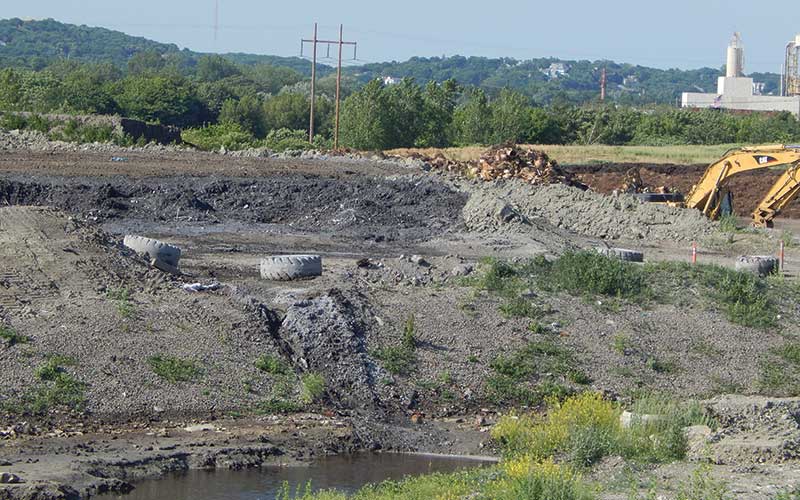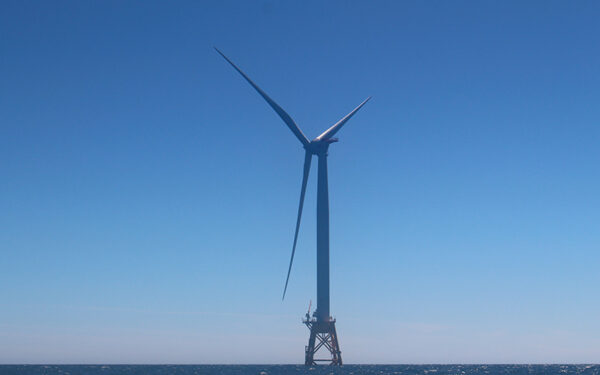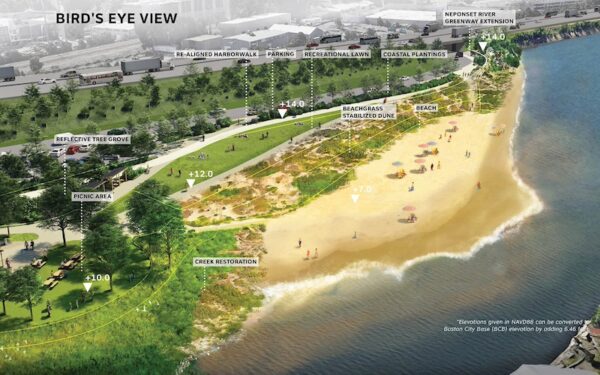
All landfills pollute our environment and move New England away from its Zero Waste goals. The Saugus Ash Landfill is one of the eight dangerous landfills trying to expand. Photo:
There’s no such thing as a safe landfill. However, expanding their acreage or the number of tons they bury each year is a surefire way to increase the pollution they emit into the air, soil, and water.
CLF’s Zero Waste Program has surveyed all 75 municipal solid waste and ash landfills operating in New England, but the ones we have looked at most closely are those trying to expand. Most of these landfills started out as small, local landfills, but Casella, Waste Management, and Wheelabrator have built them into regional mega-landfills – contrary to state policies prioritizing waste reduction over landfill expansion.
Considering that about 80 percent of what is buried in our landfills is recyclable or compostable, it’s past time to phase out landfills in New England. A good first step would be not to allow any of these proposed expansions, only three of which have been stopped – for now.
Permits to Expand Have Been Granted, But CLF is Challenging Them
1. Saugus Ash Landfill, Wheelabrator
Location: Saugus, MA
Total Size: 160 acres
Proposed Expansion: 39 acres
Tons of Waste Per Year: 113,511
Danger: Located in a marshland, Saugus Ash Landfill is unlined, leaking contaminants directly into the water that surrounds it. It lacks groundwater monitoring wells to track how much contamination it’s leaking. The landfill sits at the intersection of Saugus, Revere, and Lynn, within a mile of thousands of homes in environmental justice communities. The landfill accepts the toxic ash from Wheelabrator’s adjacent incinerator, which contains heavy metals like arsenic and lead, as well as dioxin, one of the most dangerous contaminants to human health.
How We’re Fighting Back: CLF has appealed the Massachusetts Department of Environmental Protection decision to allow the landfill to expand. It’s way past time to shut the Wheelabrator Saugus Ash Landfill down.
2. Turnkey Landfill, Waste Management
Location: Rochester, NH
Size: 217 acres
Proposed Expansion: 58.6 acres
Tons of Waste Per Year: 1.4 million, more than any other landfill in New England. If the proposed expansion is approved, it would increase the total capacity of the landfill by another mind-boggling 14 million tons over its projected lifespan.
Danger: The Turnkey Landfill is located near both the Cocheco and Isinglass Rivers – exactly the worst place for a landfill. Regulations prevent landfills from being built in sensitive wetlands, but Waste Management is trying to get around them. This expansion would be disastrous, as groundwater monitoring already indicates the presence of cancer-causing toxics that might harm the nearby community of Dover, which gets some of its water downstream of the landfill.
How We’re Fighting Back: CLF is currently working to stop the landfill from expanding.
3. Coventry Landfill, Casella
Location: Coventry, VT
Size: About 90 acres
Proposed Expansion: 51.2 acres
Tons of Waste Per Year: Permitted to accept 600,000
Danger: Contaminants fromVermont’s only landfill end up in Lake Memphrémagog, a drinking water supply for towns across the border in Canada. Monitoring at the landfill indicates it is also leaking harmful pollution, including arsenic, lead, and other heavy metals into the surrounding groundwater.
How We’re Fighting Back: CLF is currently working to stop the landfill from expanding.
Permitting Process to Expand Has Started
4. Bourne Landfill, Town of Bourne
Location: Bourne, MA
Size: About 99 acres
Proposed Expansion: About 7 acres now, and about 28 acres planned for the future
Tons of Waste Per Year: 219,000, 189,000 of which is incinerator ash
Danger: The Bourne landfill supports the operation of Covanta’s SEMASS Incinerator, where 1.1 million tons of waste is burned every year, producing more than 250,000 tons of ash. Incinerator ash contains cancer-causing compounds and harms the health of nearby communities. If we recycled or composted the waste going to SEMASS, it would eliminate 80 percent of the ash – and Bourne’s need to expand.
How We’re Fighting Back: CLF has submitted comments to the Massachusetts Environmental Policy Act office on Bourne’s Environmental Impact Report and will continue to weigh in on future permit applications.
Expansion Stopped, For Now
5. Fitchburg/Westminster Landfill, Waste Management
Location: Fitchburg and Westminster, MA
Size: 104 acres
Proposed Expansion: 85 acres in the Leominster State Forest
Tons of Waste Per Year: 538,200, more than any other landfill in Massachusetts
Danger: Like all landfills, the Fitchburg/Westminster landfill releases poisonous gases and leachate into the environment. The proposed expansion would not only damage state forest land, it would harm two neighboring environmental justice communities that already bear the brunt of the site’s pollution. Such a large expansion would slow Massachusetts’s waste reduction efforts for years to come.
How We’re Fighting Back: CLF and its allies were able to stop legislation in the Massachusetts legislature that would have allowed the 85 acres in question to be used this way. However, we expect that Waste Management will be back lobbying for an expansion when the new legislative session starts in January.
6. Bethlehem Landfill, Casella
Location: Bethlehem, NH
Size: 50 acres
Proposed Expansion: Unclear – up to 180 acres
Tons of Waste Per Year: 433,006
Danger: Despite the fact that Bethlehem residents voted twice not to allow Casella to expand the landfill, the company is still pursuing “alternative expansion options.” Meanwhile, the landfill’s proximity to the Ammonoosuc River (at the foot of the White Mountain National Forest, near campgrounds and recreation areas) presents a danger to that waterway and those who use it. 1,4 dioxane, manganese, and iron levels have all increased in the groundwater monitoring over the past several years.
How We’re Fighting Back: CLF and Toxics Action Center have sued Casella Waste for violating the Clean Water Act based on the presence of these substances in the Ammonoosuc.
7. Southbridge Landfill, Casella
Location: Southbridge, MA
Size: 58.2 acres
Proposed Expansion: A proposal for a 19-acre footprint expansion, plus increasing the height of the landfill, was shot down by the Commonwealth and local residents
Tons of Waste Per Year: 404,050
Danger: Casella, the operator of the Southbridge Landfill, is the potentially responsible party for more than 40 contaminated home wells in a neighborhood adjacent to the landfill. Meanwhile, another 35 home wells are being investigated for contamination by MassDEP in another nearby neighborhood in Sturbridge, MA. Thanks to community activism, the landfill did not receive a permit to expand and is scheduled to shut down this year.
How We’re Fighting Back: CLF supports Toxics Action Center and local residents who have sued Casella Waste for violating the Clean Water and Resource Conservation and Recovery Acts based on the presence of contaminants in surface waters and home wells.
Permit to Expand Granted
8. Juniper Ridge Landfill, Casella
Location: Old Town, ME
Size: 68 acres
Proposed Expansion: 54 acres
Tons of Waste Per Year: 497,652
Danger: The Juniper Ridge Landfill is just a few miles from the Penobscot Reservation and sits on land that is valued by the Penobscot Nation. Groundwater samples have found arsenic levels that exceed state and federal maximum levels, and the landfill threatens to continue leaking toxins into the Penobscot River and Pushaw Stream.
Zero Waste is the Solution
We accept dangerous landfills and incinerators because public officials fail to enforce waste reduction policies, captives of waste companies that constantly tell us that burning or burying our trash is the only way to deal with our waste. That’s simply not true. Zero Waste programs give people and businesses a chance to reduce, reuse, recycle, and compost almost all of the valuable materials that would otherwise be thrown away. Zero Waste programs save cities, towns, and businesses money, create more jobs than incinerators and landfills, and are much better for the environment and public health.
William Wilson contributed to reporting this piece.



